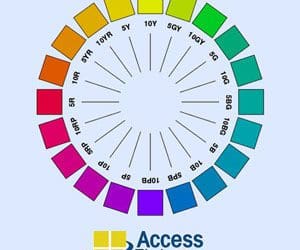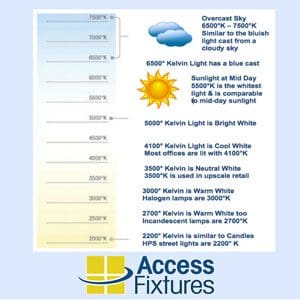The Color Rendering Index (CRI) is a crucial concept in the lighting industry, indicating a light source’s ability to display colors in their truest forms accurately. It assesses how well a light source represents various shades, making it a significant factor in choosing lighting for any project. Expressed as a number on a scale of 0 to 100, a higher CRI indicates better color accuracy. A CRI of 70 or higher is generally considered appropriate for high-quality and energy-efficient lighting products. Essentially, CRI measures how a light source makes colors appear, emphasizing the importance of choosing lighting that renders colors accurately to the human eye.
What is Color Rendering Index (CRI)?
The Color Rendering Index (CRI) is a measure of how well a light source accurately renders the colors of objects it illuminates. Essentially, it quantifies the ability of a light source to reveal the true colors of objects in comparison to a natural or standard light source. Defined by the International Commission on Illumination (CIE), CRI evaluates the effect of an illuminant on the color appearance of objects by comparing it with a reference or standard illuminant. This makes CRI a crucial metric for assessing the color rendering capability of various light sources, ensuring that the colors we see under artificial lighting are as close to their natural appearance as possible.
How Does the Color Rendering Index Work with Color Temperature?
Color rendering is measured on a scale called the color rendering index (CRI), which runs from 0 to 100 percent. It indicates the accuracy of a light when compared to a reference light source. A reference light source such as daylight or incandescent light is used as a benchmark for the accuracy and suitability of the light. Halogen light sources, with their color temperatures below 5000K, are also used in CRI calculations to compare against the Planckian radiation spectrum. The closer the CRI is to 100 percent, the more accurate the light source will render a color’s appearance. For example, a CRI of 95 represents considerable value, while a low CRI rating indicates that some colors will not appear as vividly when illuminated.
CRI and color temperature are similar in that they are often measured by their ability to render colors. The color rendering index is an independent method of describing characteristics of light, for example, and is different than the measurement of Kelvins (warm and cool light).
Understanding CRI Values and Ranges
CRI values range from 0 to 100, with higher values indicating better color rendering. A CRI of 100 represents the highest possible color accuracy, akin to natural sunlight, while a CRI of 0 represents the lowest, where colors appear distorted. The CRI value is determined by the light source’s spectrum. For instance, incandescent lamps, which have a continuous spectrum, typically score high on the CRI scale, whereas fluorescent lamps, with their discrete line spectrum, may score lower.
-
CRI values above 90: These are considered high and are ideal for applications where color accuracy is paramount, such as photography, retail stores, and art galleries.
-
CRI values between 80 and 90: These are considered good and are suitable for most commercial applications, providing a balance between color accuracy and energy efficiency.
-
CRI values below 80: These are considered poor and may not render colors accurately, making them less suitable for tasks requiring precise color discrimination.
Understanding these ranges helps in selecting the right light source for specific needs, ensuring optimal lighting quality and color accuracy.
How is the CRI Used?
We have now established that a high CRI is better than a low CRI, but three questions immediately follow: What exactly is measured, how are those measurements taken, and is there value in having a CRI as high as 95? The color rendering index is a commonly recognized metric and the only means available for accurately evaluating and reporting the color rendering of light sources. While CRI is based on eight defined color samples, the results of a CRI evaluation are found mathematically. The predefined color chart is used to evaluate the appearance of specific colors and compare them to the reference light source (discussed above).
A high CRI light source is essential in applications where accurate color rendering is critical, such as in photography and art galleries.
The eight defined colors used to measure CRI are from the Munsell color wheel. To run accurate color comparisons, the color temperatures of the reference light source and the test light must be identical. For example, it is a misconception that a light source with a high CRI will produce light similar to a bright sunny day, making your home look like the sun is beaming inside. This is incorrect. CRI measures how accurately a light source compares to a similar light source of the same color temperature.
The Importance of Color Rendering in LED Lights
Color rendering is a critical factor when selecting LED lights. High CRI LED lights can accurately render colors, making them indispensable for applications where color accuracy is crucial. For example, in photography, retail stores, and art galleries, the ability to see true colors can significantly impact the quality of work and customer experience.
High CRI LED lights not only enhance color accuracy but also improve the overall ambiance and aesthetic of a space. Whether it’s a cozy home setting or a vibrant retail environment, the right lighting can make a significant difference. By choosing LED lights with high CRI values, you ensure that the colors in your space are vivid and true to life, enhancing both functionality and visual appeal.
Other Ways to Measure Color Rendering
Aside from CRI, another common way of measuring light quality is by correlated color temperature (CCT). CCT is a form of measuring a light source using Kelvin (K) temperature. Kelvin temperature specifies the warmth or coolness of a color’s appearance. A low Kelvin temperature will be softer and warmer, while a higher Kelvin temperature will be cool light. For example, 3000K is considered warm white because it falls more toward the yellow end of the white-light spectrum and is typically used to instill comfort (often used in homes and restaurants). 4000K can be considered neutral white and is one of the most popular Kelvin temperatures for LED sports lighting. Lastly, 5700K, or cool white, falls close to the blue end of the white-light spectrum and offers a crisp and clean color often compared to daylight.
While CCT classification of a light source gives an overall positive representation of the appearance of a lamp, this is not always the case. Two lamps may have the same CCT, but when used for their intended purpose, the colors are not the same. This is because it is rare that a color is made up of just one solid, defined color. More likely than not, the application will have many colors and shades. Therefore, something with the same CCT can result in different results.
Measuring Light With Color Quality Scale
Another way of measuring a light source’s quality is by color quality scale (CQS). Traditionally, we have measured light sources using CRI. CQS is a new way of measurement and may eventually eliminate CRI. The main reason behind this movement is the challenge of measuring LEDs with CRI. CRI measurement gets more complicated when you consider that its natural light source is a black body radiator and, as mentioned previously, is based on eight colors. Incandescent bulbs receive a CRI of 100, yet they are far from ideal color rendering. And, vice versa, a light source can receive a poor CRI score even if it works well with bright colors. For example, LEDs can accurately illuminate bright or saturated colors but not always unsaturated colors. A low CRI for LED lighting can be misleading. CQS is an alternative method that uses 15 colors that span a broader range of object colors. Additionally, CQS considers factors such as chromatic discrimination and human preference.
Limitations of CRI
While CRI is a valuable measure of color rendering, it does have its limitations. One significant limitation is that CRI does not account for the color temperature of the light source, which can also affect color appearance. For instance, two light sources with the same CRI but different color temperatures can render colors differently.
Additionally, CRI only measures the ability of a light source to render colors accurately based on a set of test color samples, but it does not consider other factors that can influence color perception. This is where the Color Quality Scale (CQS) comes into play. CQS is an alternative measure that addresses some of the shortcomings of CRI by using a broader range of colors and considering factors such as chromatic discrimination and human preference. While CRI remains a widely used metric, understanding its limitations and the potential benefits of CQS can help in making more informed lighting choices.
Applications That Require a High CRI and Fixtures That Deliver High CRI LED Lighting
Access Fixtures offers a wide range of high CRI fixtures, such as those in the APTA and APTO families. These fixtures come standard in 70+ CRI but are available at 80+ CRI and 90+ CRI at a minimal extra cost. APTA fixtures are high-powered pole lights used for sports lighting applications, park lighting, and anywhere a maximum amount of footcandles is desired. APTO fixtures are full cutoff wall packs in two different designs.
High CRI lighting enhances color accuracy and overall aesthetics, making it ideal for art galleries, commercial spaces, and residential interiors.
Applications that typically require a high CRI include LED sports lighting, indoor manufacturing facilities, car detailing shops, retail stores, studios, art museums, and other properties where excellent visibility and color rendering accuracy are crucial.
Speak to an Access Fixtures Lighting Specialist or Start Shopping Now
Access Fixtures is your factory-direct source for high-quality lighting, including LED industrial and warehouse lighting. Request a call from an Access Fixtures lighting specialist for more information on the best solution for your application, or simply call 800-468-9925.
Conclusion
Color Rendering Index (CRI) and Lighting Frequently Asked Questions (FAQs)
What is the Color Rendering Index (CRI)?
The Color Rendering Index (CRI) is a measure of how accurately a light source renders the colors of objects compared to a natural or standard light source, like daylight. It’s expressed on a scale from 0 to 100, with higher values indicating better color accuracy. Defined by the International Commission on Illumination (CIE), CRI evaluates a light source’s ability to reveal true colors, making it a key metric for assessing lighting quality in various applications.
How does CRI work with color temperature?
CRI measures color accuracy by comparing a light source to a reference source, such as daylight or incandescent light, at the same color temperature, which is measured in Kelvins. For example, a CRI of 95 indicates high color accuracy, but CRI is independent of color temperature, which describes the warmth or coolness of light, like 3000K for warm white or 5700K for cool white. This means two lights with the same CRI but different color temperatures can still render colors differently.
What do CRI values and ranges mean?
CRI values range from 0 to 100, where a CRI of 100, like natural sunlight, offers the best color accuracy, and a CRI of 0 severely distorts colors. A CRI above 90 is ideal for color-critical tasks such as photography or art galleries, while 80–90 is good for most commercial uses, balancing color accuracy and efficiency. Values below 80 are considered poor, as they may not render colors accurately, making them less suitable for tasks requiring precise color discrimination.
How is CRI measured?
CRI is measured by comparing how a light source renders eight predefined colors from the Munsell color chart against a reference light source of the same color temperature. The results are calculated mathematically to determine how accurately the light source displays these colors. A higher CRI indicates better performance, but the measurement focuses on color accuracy, not the overall appearance of the light, such as mimicking a bright sunny day.
Why is a high CRI important for LED lights?
High CRI LED lights accurately render colors, which is essential for applications like photography, retail stores, and art galleries where true color representation enhances quality and customer experience. Beyond functionality, high CRI LEDs also improve the ambiance and aesthetics of spaces, making colors vivid and true to life. Whether in a cozy home or a vibrant retail environment, choosing high CRI LEDs ensures better visual appeal and clarity.
What is the difference between CRI and correlated color temperature (CCT)?
CRI measures how accurately a light source renders colors, while correlated color temperature (CCT), measured in Kelvins, describes the warmth or coolness of the light’s appearance, such as 3000K for warm white, 4000K for neutral white, or 5700K for cool white. Two lights with the same CCT can have different CRIs, leading to varying color accuracy. This distinction is important because CCT affects the overall mood, while CRI ensures color fidelity.
What are the limitations of CRI?
CRI doesn’t account for the light source’s color temperature, which can influence color appearance, meaning two lights with the same CRI but different temperatures may render colors differently. Additionally, CRI only measures eight color samples, overlooking factors like chromatic discrimination or human preference. This can make CRI less accurate for LEDs, which may render bright colors well but struggle with unsaturated colors, potentially resulting in misleadingly low CRI scores.
What is the Color Quality Scale (CQS), and how does it differ from CRI?
The Color Quality Scale (CQS) is an alternative to CRI that uses 15 colors across a broader range, addressing CRI’s limitations by considering factors like chromatic discrimination and human preference. Unlike CRI, which relies on eight colors and a black body radiator reference, CQS is better suited for measuring LED lighting, as it accounts for a wider spectrum of colors and human perception. CQS may eventually replace CRI as a more comprehensive metric for light quality.
What applications require a high CRI, and what fixtures provide it?
High CRI is essential for applications like LED sports lighting, indoor manufacturing, car detailing shops, retail stores, studios, art museums, and residential garages, where color accuracy and visibility are critical. Access Fixtures offers high CRI fixtures like APTA pole lights for sports and park lighting, and APTO full cutoff wall packs, with standard 70+ CRI and optional 80+ or 90+ CRI at a minimal extra cost, ensuring excellent color rendering for various settings.
How can I choose the right lighting for my project?
To choose the right lighting, consider the CRI for color accuracy—aim for 80+ for most applications or 90+ for color-critical tasks like art galleries—and the correlated color temperature (CCT) for ambiance, such as 3000K for warm, cozy settings or 5700K for crisp, daylight-like lighting. For personalized guidance, contact an Access Fixtures lighting specialist at 800-468-9925 or visit their website to explore high CRI LED options tailored to your specific needs.




